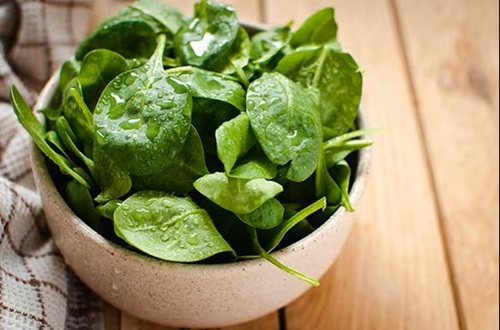Feb 27th 2025
How to Grow Spinach with Hydroponics
Growing Conditions for Spinach Hydroponics: The Basics
To produce spinach you don't need a degree in agriculture, let alone experience with hydroponics. Here are some essentials for hydroponically cultivating spinach.

For indoor gardening, it’s crucial to choose varieties that flourish in containers and under limited light. Here are the best picks:
- 5.8 - 6.5 pH tolerance (ideally 5.8 - 6.0)
- The ideal temperature range is 60–68 degrees Fahrenheit (15–20 degrees Celsius).
- 30 to 45 days for growth
- Compatible with LED or fluorescent grow lights
- Photoperiod: 10–14 hours of light per day
- If the entire plant is being harvested, re-germinate every two weeks.
The Best Hydroponics System for Spinach
Systems that enable the equal and even flow of nutrients are ideal for spinach growth. For spinach production, a Nutrient Film Technique (NFT) or aeroponics method is often recommended. These systems enable high-quality nutrients supply and oxygenation, both of which are essential for spinach's quick and healthy development.
Growing Spinach Hydroponically
Seed Selection and Preparation
Start by selecting premium spinach seeds from a reliable vendor. Choose a variety according on your preferences and the particulars of your hydroponic system. Varied varieties provide varied flavors and growing qualities. The majority of spinach seeds don't require any particular processing. However, you may choose to soak the seeds in water for a whole day to accelerate germination.Germination
Using rock wool or coco coir, two common hydroponic mediums – plant the seeds in a germination tray. Place one or two seeds into each cube, about 1/4 inch deep. Cover the tray with plastic wrap or a humidity dome after misting the cubes with water. In around a week, the seeds should begin to sprout if the tray is kept warm between 60 and 75 degrees Fahrenheit (15 - 24 degrees Celsius).Seedling Care and Transplanting
After the seeds have sprouted, expose them to a light source. You may use fluorescent lights with an adjustable light cycle or LED grow lights. The growth material should be kept moist but not soggy. When the seedlings have four leaves, you may transfer them to your hydroponic system. Handle the seedlings carefully so as not to damage the delicate roots.Nutrient Solution, Lighting and Temperature
Proceed to make the solution in accordance with the manufacturer's instructions. Spinach thrives when the pH of the solution is between 5.8 and 6.0. Keep in mind that maintaining this pH balance may be simple using a program like Grower. Every day, give the spinach plants 10 to 14 hours of light. Spinach loves colder temperatures, ideally a temperature range of 60–68 degrees Fahrenheit (15–20 degrees Celsius). This may be too cold for your home so it’s reasonable to go above this range, but try to keep things below 78 degrees Fahrenheit if you can. (25 degrees Celsius).Harvesting Hydroponic Spinach
A spinach plant may take 45 days to mature, although you can usually start harvesting earlier. You can start harvesting the outer leaves as soon as the plant has formed distinct inner and outer leaves. The "cut and come again" approach of harvesting loose leaves, is identical to harvesting lettuce with this procedure.To get sweeter spinach leaves, you have to adjust a few variables in your hydroponic system before harvesting. Just before your plants reach maturity, lower the temperature by a few degrees if you can and cut back on the fertilizers you're giving them.
When it's time to harvest, snip off the outer leaves first. The smaller inner leaves can then be harvested if they are large enough for your needs, or you can decide to leave them on the plant to continue growing.
Understanding How pH Affects Spinach Growth

According to a ground-breaking study, spinach growth was considerably impacted by reducing the pH of the nutritional solution. In particular, when spinach was grown at pH 4.0, the elemental concentrations—which are vital elements for plant growth—were at their lowest.
It's interesting to note that when spinach was cultivated at pH values of 4.5, 5.0, and 5.5, it showed typical shoot and root development. At pH values of 4.5 and 5.0, any loss in shoot development appeared to be due to a reduction in nutrient absorption rather than a direct pH impact. As you can see spinach is rather pH sensitive, so keep your solution between 5.8 and 6.0 as best you can.
How to Store Hydroponic Spinach
You can store spinach the same way you would any other spinach once it has been picked. Although hydroponically produced spinach will generally survive a lot longer than conventionally grown spinach from the grocery store, there are still a few tips you may want to follow to prolong its freshness.If your spinach isn't in an airtight container, keep it away from food that produces ethylene, such as apples and bananas. Exposure to ethylene can accelerate the aging process and early spoilage of spinach.
FAQ
Is it possible to produce spinach indoors all year round?
If you decide to grow spinach indoors, be sure to set up plant grow lights, or use a hydroponic kit like our GX Hydroponic Tower with Grow Lights if you want to grow year-round. This will allow you to control all the conditions that plants need to grow.
What kind of nutrients does spinach need in a hydroponic system?
In addition to vital micronutrients like calcium and magnesium, spinach requires a nutritional solution that contains the right amounts of nitrogen, potassium, and phosphorus. To guarantee ideal spinach development, use an A & B nutrient mix made for hydroponics and regularly check and modify the solution's pH and nutrient levels.




